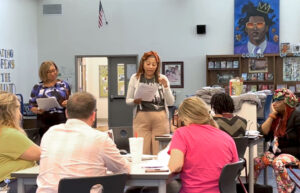Nothing says “tired” like the face of a first-year teacher in late October. Last fall, when I took stock of the newly minted educators in my English Language Arts seminar for Arizona Teaching Fellows, I couldn’t help but feel a little sorry for them. We were analyzing a video of a challenging and engaging lesson aligned to the Arizona College and Career Readiness standards, which match the Common Core State Standards in focus and rigor. I knew in the back of their minds, these new teachers were all thinking, “I’m never going to be able to pull off that in my classroom.”
It’s a valid concern. Even for veteran educators, teaching to the level of the Common Core standards can feel daunting—especially in schools where too many students weren’t mastering the previous, less rigorous standards. So how can we prepare new teachers for the level of rigor required by the Common Core standards?
This summer, as we work to evolve our training model for new teachers from Maryland to Arizona, figuring out how to set up new teachers for success with the Common Core standards is one of our most important undertakings. It’s also one of the toughest: A book that would have been considered appropriate for eighth graders under the old Lexile Ranges can now be taught in a fifth grade classroom. Students are no longer expected to merely “do math”—they have to be able to explain the concepts behind the math. Raising expectations like this is crucially important for students, but it’s a big shift for teachers.
While we’re still asking a lot of questions, a few key strategies have emerged that are helping us get new teachers ready to master the Common Core standards:
Invest new teachers in a common vision of excellence. You can’t replicate something until you understand it. In our pre-service training, we spend hours in content-specific groups analyzing exemplar videos, student work samples and unit plans, so that teachers enter the classroom with a goal in mind for their instruction. Luckily, new teachers are easily invested in the Common Core standards because they match their intuitive vision for strong teaching. No one signs up to be a teacher because they are passionate about passing out worksheets. New English teachers imagine their students reading and writing about great literature. Math teachers dream of watching small groups of students use calculators and protractors to solve complex, real-world engineering problems. That’s the Common Core standards in action.
Make the process linear, even if the product isn’t. Learning to teach to the Common Core standards is sort of like learning to cook a complicated dish, with a lot of ingredients that you can’t just throw together. Teachers new to the standards need a recipe of sorts—a series of steps to transform a blank planning template into the type of quality instruction they see in the exemplar videos. In my ELA seminar, we start with an anchor text (To Kill a Mockingbird, for example) and brainstorm a list of supporting texts that could aid students in better understanding the key concepts of the novel. Then we analyze the standards and determine which ones are well-suited to be taught in this unit. From there, we go back to the texts and ask, “What must students know or be able to do in order to deeply understand what they are reading?” Those answers guide how we create text-based questions and tasks because, ultimately, the goal of the Common Core ELA standards is to empower students to better understand their world by understanding rich, complex texts.
Plan great units together. Gone are the days when a single objective could be taught and assessed in one class period. With the Common Core standards, students are asked to think as critically about content in class as they would in the real world. Instead of spending one class period reviewing Dr. Martin Luther King, Jr.’s Letter from the Birmingham Jail, an ELA teacher might devote three days to multiple readings of this text, moving from basic comprehension to a deep analysis of the author’s purpose. The latter takes longer, but the learning will last longer, too. By helping our teachers plan backwards from a culminating task or around a single theme, we’ve found that they’re more confident deciding what their day-to-day instruction should look like.
Keep classroom culture front and center. Even the most immaculately planned lessons will fail if students are disengaged or feel unsafe taking academic risks. The “what” of the Common Core standards matters little without the “how” of skilled instruction. That’s why we still spend most of our summer helping our Fellows internalize basic skills, like giving clear directions and addressing student behaviors. This way, when our teachers are actually in front of their classes, they’re able to focus on Shakespeare—not what to do about the two students talking in the back of the room.
Some big questions remain: How do you effectively remediate struggling students while still exposing them to grade-level content? What if the curricula mandated by a district is not Common Core-aligned? How can teachers adapt pre-existing resources to meet the needs of their school and students? Like the Common Core itself, these questions are complex and a little daunting. But if our new teachers are up for the challenge, so are we.







